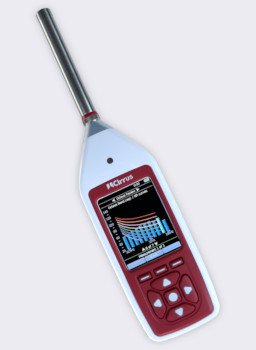

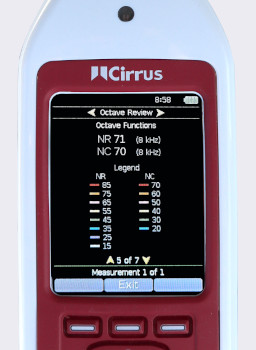
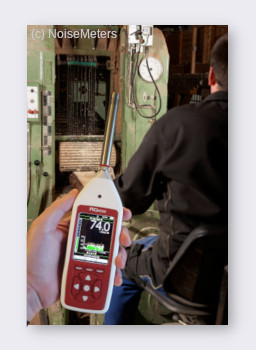
The delivery price is calculated during checkout based on your location and the goods ordered. Our basic delivery prices are:
Delivery within Ireland: €27.00
Delivery Service: Three working days*
* For products that are in stock and the order received by midday.
Some products go through a final configuration and calibration before being shipped. If the calibration labs are busy this can add up to two days on to the delivery schedule but guarantees a fresh calibration.
This model of Optimus Red sound level meter adds NR and NC calculations and curves to all the other noise measurement parameters. The result is a meter that is ideal for noise at work assessments as well as indoor noise rating for air conditioning units and similar equipment.
The sound level meter is fitted with real-time octave band filters that measure in all bands at the same time. This makes it ideal for Noise Rating and Noise Criterion calculation.
Octave bands gives a description of the frequency content of the noise measured. The most common use is for selecting the correct hearing protectors, ensuring that they attenuate the sound levels at the frequencies of interest.
The NR and NC values are calculated using the octave band filter measurements. They provide a single number result that takes into account the frequency content, which can be used when assessing equipment such as air conditioning units.
Commonly used in Europe, the Noise Rating or NR was developed by ISO for determining the acceptable levels for hearing preservation, speech communication and annoyance factor.
The Noise Criterion is commonly used in the US for rating indoor noise from equipment such as air conditioning.
Commonly used in Europe, the noise rating value is generally used for assessing the indoor noise levels, often in connection with air conditioning units and similar indoor equipment. Some example applications along with typical NR levels are:
The sound level meter carries out all the calculations for you. NR calculations are carried out from the octave band measurement results. The octave band measurements are compared with the standard Noise Rating Curves. The NR value is the lowest NR curve that is not exceeded by any of the octave band measurements.
The NR calculation process is better shown on a chart. This shows an example for explanation purposes, it is not a screen image from the Optimus sound level meter.
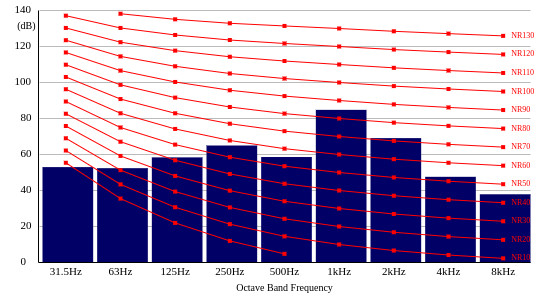
The blue bars show the octave band measurements. The red lines are the standard noise rating curves. This example would return a noise rating value of 85 dB.
Commonly used in the US, the noise criterion value is for assessing the indoor noise levels, often in connection with air conditioning units and similar indoor equipment. Some example applications along with typical NC levels are:
The sound level meter carries out all the calculations for you. NC calculations are carried out from the octave band measurement results. The octave band measurements are compared with the standard Noise Criterion Curves. The NC value is the lowest NC curve that is not exceeded by any of the octave band measurements.
The NC calculation process is better shown on a chart. This shows an example for explanation purposes, it is not a screen image from the Optimus sound level meter.
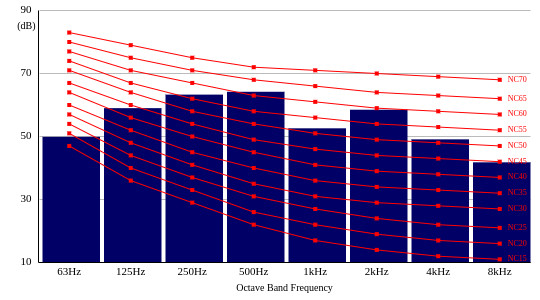
The blue bars show the octave band measurements. The red lines are the standard noise criterion curves. This example would return a noise criterion value of 62 dB.
This meter and the noise measurement kits include the NoiseTools software - there is no extra charge for this. You can download the software to evaluate it before making a purchase.
The NoiseTools software runs on a Windows PC. It is compatible with all recent versions of Windows, from Windows 7 onwards.
There are not too many options for this version of the Optimus Red sound level meter as most are included. It includes all the parameters that you need for occupational noise measurements in line with the regulations and directives. It also has real-time octave band filters fitted and comes with data logging and the NoiseTools software.
The main options are:
The most important of the accessories is the Calibrator. The regulations state that you should use one to check the function of the meter before and after making any measurements.
A Class 1 sound level meter is a little more accurate than a Class 2 model. It is also more expensive. If you are using the meter exclusively for occupational noise measurements then the regulations are quite clear: Class 2 is adequate. For this reason we recommend the Class 2 model.
However, if you need to make other noise measurements, such as noise emitting from your factory into the local environment, then it might be wise to go for a Class 1 meter. In these instances the local authority (Environmental Health Officer for example) will usually expect measurements made with a Class 1 meter.
The Noise Measurement Kits, order codes CK162D and CK161D, include a sound level meter (with octave bands and NR/NC calculations), calibrator of the correct class, software, carrying case and download cable.
| Standards | IEC 61672-1:2013 Class 1 or Class 2 |
| IEC 61672-1:2002 Class 1 or Class 2 Group X | |
| IEC 60651:2001 Type 1 I or Type 2 I | |
| IEC 60804:2000 Type 1 or Type 2 | |
| IEC 61252:1993 personal sound exposure meters | |
| ANSI S1.4 -1983 (R2006), ANSI S1.43 - 1997 (R2007), ANSI S1.25:1991 | |
| IEC 61260:1996 & ANSI S1.11-2004 | |
| DIN 45657:2005-03 | |
| Measurement Range | 20dB to 140dB RMS single range |
| Noise floor | <18dB(A) Class 1, <21dB(A) Class 2 |
| Frequency weightings | RMS & peak : A, C, & Z measured simultaneously |
| Frequency bands | 10 octave bands, 31.5Hz to 16kHz |
| Time weightings | Fast, Slow & Impulse measured simultaneously |
| Memory | 8GB, 32GB factory fit option |
| Time history data rates | 10ms, 62.5ms, 125ms, 250ms, 1/2 sec, 1 sec or 2 sec |
| VoiceTag | Up to 30 seconds of audio notes with each measurement |
| Integrators | Three simultaneous “virtual” noise meters. Integrator 1 is preset to Q3 for Leq functions. Integrators 2 & 3 can be configured with the following |
| Exchange rate | 3, 4 or 5 dB |
| Threshold | 70dB to 120dB (1 dB steps) |
| Time weighting | None or Slow |
| Criterion level | 70dB to 120dB (1 dB steps) |
| Criterion time | 1 to 12 hours in 1 hour steps |
| Integrator quick settings | EU, OSHA HC & OSHA NC, OSHA HC & ACGIH, MSHA HC & MSHA EC, Custom |
| Size | 283mm x 65mm x 30mm |
| Weight | 300gms/10oz |
| Power | 4 x AA alkaline |
| Typically 12 hours with alkaline AA | |
| Typically 20 hours with lithium AA non-rechargeable | |
| External power: 5v-15v via MultiIO socket via ZL:171 cable (2.1mm socket) | |
| Outputs | USB Type B to PC |
| AC & DC output via ZL:174 (2 x Phono, 1m) | |
| Multi-pin IO for external power via ZL:171 cable (2.1mm socket) | |
| Bluetooth BLE compatible with Anrdoid and iOS devices | |
| Case | Material: high impact ABS-PC with soft touch back and keypad |
| Tripod mount | 1/4" Whitworth socket |
| Environmental | Temperature: Operating -10°C to +50°C, storage -20°C to +60°C |
| Humidity: Up to 95% RH non-condensing | |
| Electromagnetic performance | IEC 61672-1:2002, IEC 61672-2:2003, IEC 61672-1:2013 & IEC 61672-2:2013 |
| Except where modified by EN 61000-6-1:2007 & EN 61000-6-1:2007 | |
| Language Options | English, French, German, Spanish, Italian |
| Display functions | LXY, LXYMax, LXYMin, LXeq, LCPeak, LZPeak, LCeq-LAeq, LXE |
| Graph of short LAeq, LCPeak, TWA, dose%, est dose% | |
| Measurement run time | |
| Real-time octave band filters | |
| Stored functions | LXYMax & time history of LXYMax |
| LAeq, LCeq, LZeq, LCPeak, LZPeak, LAPeak, Lavg, TWA. %dose | |
| Time history of LAeq, LCeq, LZeq, LCPeak, LZPeak, LAPeak, LAIeq, Lavg | |
| Octave bands models: overall Leq & Leq time history for each band | |
| where x=A ,C ,Z; y= F, S, I |